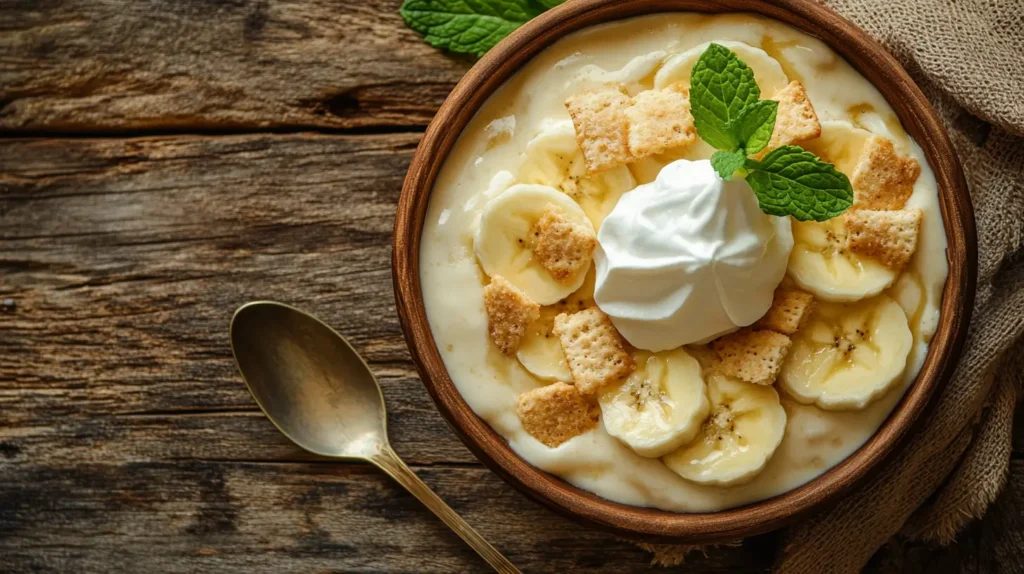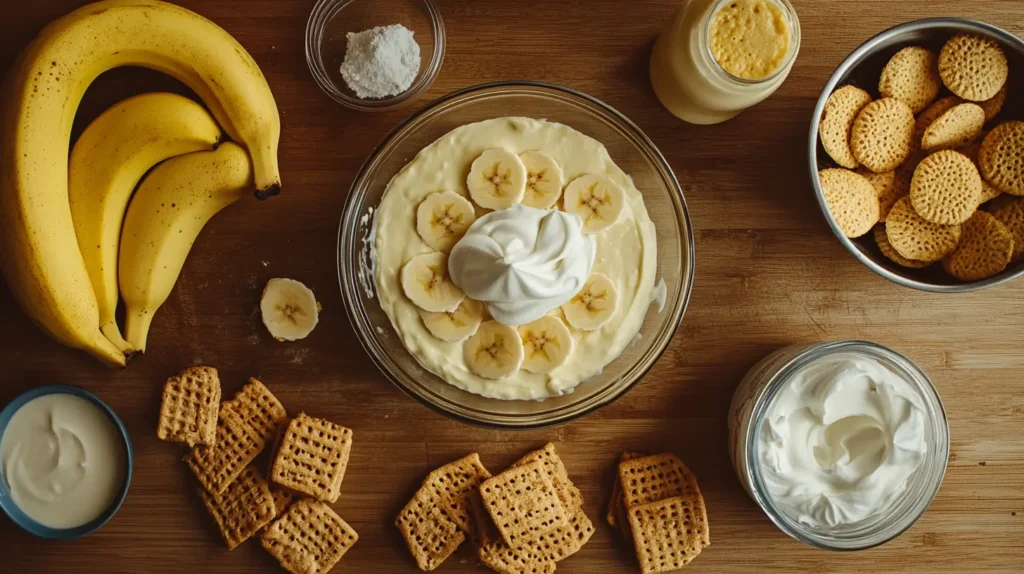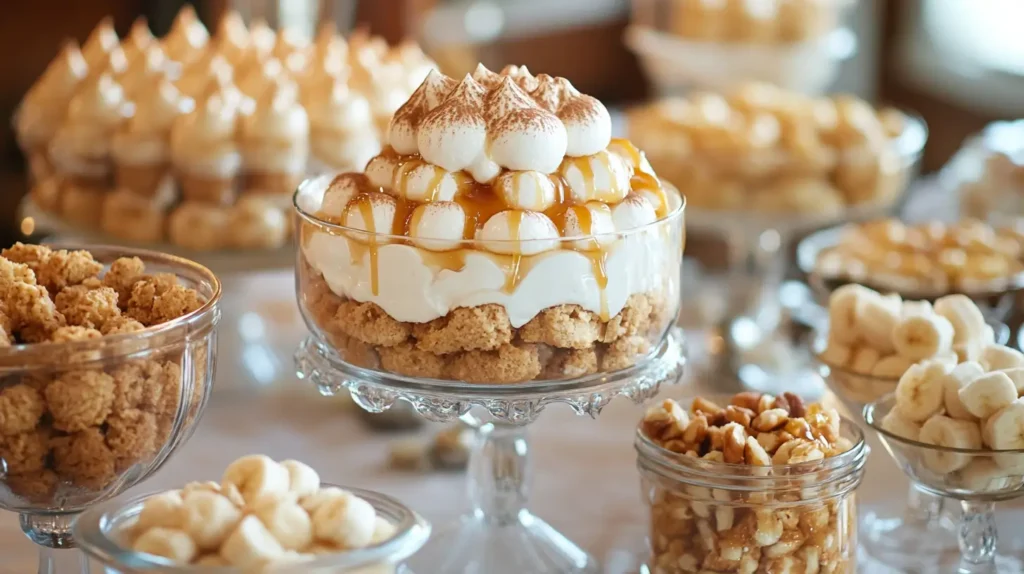Why is banana pudding so good? This classic dessert holds a special place in the hearts of dessert lovers everywhere. With its creamy texture, layers of vanilla wafers, ripe bananas, and rich custard or pudding, banana pudding has been a staple in households, potlucks, and family gatherings for generations. Whether served warm or chilled, topped with whipped cream or meringue, it embodies comfort and nostalgia.

Its popularity stretches far beyond its Southern roots, finding its way into bakeries, restaurants, and even trendy dessert menus worldwide. The combination of simple ingredients and indulgent flavors makes it a go-to choice for those craving something sweet yet familiar. From homemade recipes passed down through generations to gourmet versions with unique twists, banana pudding continues to capture hearts and taste buds alike.
Table of Contents
The History of Banana Pudding
Origins, Southern Roots, and Cultural Impact
Banana pudding has a rich history that dates back to the late 19th century when bananas became more widely available in the United States. Inspired by traditional English trifles, early recipes featured layers of custard, sponge cake, and bananas. However, it was in the American South that banana pudding truly found its identity, evolving into the beloved dessert we know today. The introduction of vanilla wafers in the 1920s further solidified its place in Southern cuisine, making it a staple at gatherings, church socials, and Sunday dinners.
The cultural impact of banana pudding extends beyond the South, with its comforting flavors resonating across different regions and generations. It has become more than just a dessert—it’s a symbol of hospitality, warmth, and tradition. From homemade family recipes to bakery and restaurant variations, banana pudding continues to be a cherished part of American food culture.
So, why is banana pudding so good? The answer lies in its perfect balance of flavors and textures. The soft, ripe bananas blend harmoniously with the smooth, creamy pudding, while the vanilla wafers add a delightful crunch that softens over time. The combination of sweetness, richness, and nostalgia makes every bite a comforting experience, evoking memories of home and shared moments with loved ones.
Key Ingredients That Make Banana Pudding Delicious
Bananas, Vanilla Wafers, Pudding, and Whipped Cream
The magic of banana pudding comes from its simple yet perfectly balanced ingredients. Each component plays a crucial role in creating the dessert’s signature taste and texture.
- Bananas: The star ingredient, ripe bananas add natural sweetness and a soft, creamy texture that blends seamlessly with the pudding. Their slightly caramelized flavor intensifies as the dessert sits, making each bite even more flavorful.
- Vanilla Wafers: These classic cookies provide a delightful contrast to the creamy pudding, starting off crisp and gradually softening as they absorb moisture. This transformation creates a melt-in-your-mouth experience that enhances the overall indulgence.
- Pudding: Whether homemade or store-bought, the rich, velvety pudding binds all the ingredients together. Vanilla or banana-flavored pudding adds depth and smoothness, making the dessert irresistibly creamy.
- Whipped Cream: A light and airy topping, whipped cream adds a layer of fluffiness that balances out the density of the pudding. Some recipes use meringue instead, offering a slightly toasted, marshmallow-like finish.

The Perfect Balance of Textures and Flavors
Creamy Pudding, Soft Bananas, Crunchy Wafers
One of the main reasons why banana pudding is so good is its incredible balance of textures and flavors. Every spoonful offers a delightful contrast—smooth and creamy pudding, soft and naturally sweet bananas, and the slight crunch of vanilla wafers that gradually turn into a cake-like consistency. This perfect combination creates a dessert that is both satisfying and comforting.
The pudding provides a velvety, rich base that coats every bite, making the dessert irresistibly creamy. The bananas, when perfectly ripe, add a sweet, fruity flavor that deepens as they blend with the pudding. Meanwhile, the vanilla wafers start off crunchy but soften over time, absorbing the flavors and creating a melt-in-your-mouth experience.
So, why is banana pudding so good? It’s the way these elements come together, creating a dessert that is both indulgent and nostalgic. The creamy pudding contrasts beautifully with the soft bananas, while the wafers add just the right amount of texture to keep every bite interesting. This balance of flavors and textures makes banana pudding a timeless favorite that continues to win hearts with every spoonful.
The Science Behind the Irresistible Taste
Sweetness, Umami, Nostalgia Factor
Banana pudding has an undeniably comforting and delicious appeal, and science helps explain why. The natural sweetness of ripe bananas pairs perfectly with the creamy, rich texture of pudding, creating a satisfying mouthfeel. Additionally, the umami notes from ingredients like vanilla wafers and dairy-based pudding enhance the overall flavor complexity. But perhaps the most powerful factor is nostalgia—many people associate banana pudding with childhood memories, family gatherings, or Southern comfort food traditions. This emotional connection amplifies its appeal, making it a treat that’s as mentally satisfying as it is delicious. So, why is banana pudding so good? It’s the perfect blend of sweetness, umami, and nostalgia, creating an irresistible dessert that keeps people coming back for more.
Why Banana Pudding Is a Comfort Food
Emotional Connections and Memories
Why is banana pudding so good? The answer lies not just in its delicious taste but also in the deep emotional connections it fosters. Many people associate banana pudding with cherished childhood moments, family gatherings, and special celebrations. Why is banana pudding so good? Because it carries the warmth of homemade desserts, often passed down through generations.
Beyond nostalgia, why is banana pudding so good? Its creamy texture and balanced sweetness provide a sense of comfort and indulgence. The familiar flavors of bananas, vanilla wafers, and pudding create a soothing experience, reinforcing positive memories. Why is banana pudding so good? It evokes feelings of warmth, security, and happiness with every bite.
Another reason why is banana pudding so good is its association with Southern hospitality and tradition. It’s a dessert that brings people together, making it more than just a sweet treat—it’s an experience. Ultimately, why is banana pudding so good? Because it’s more than food; it’s a heartfelt reminder of joy, love, and togetherness.
Variations of Banana Pudding
Classic, Baked, No-Bake, Gourmet Versions
There are countless ways to enjoy this beloved dessert, but why is banana pudding so good? One reason is its versatility. Whether you prefer the traditional Southern style or a modern twist, there’s a version for everyone. Why is banana pudding so good? Because it can be made in different ways while still maintaining its signature comforting taste.
The classic banana pudding features layers of ripe bananas, vanilla wafers, and creamy pudding, often topped with whipped cream or meringue. Why is banana pudding so good? This version has stood the test of time, offering the perfect balance of sweetness and texture.
For those who love a warm dessert, the baked banana pudding takes things up a notch. After layering the ingredients, it’s baked until the top becomes golden and slightly crispy. Why is banana pudding so good? The contrast of warm and cool textures makes each bite even more satisfying.
If convenience is key, the no-bake banana pudding is a simple yet delicious alternative. With instant pudding and pre-made whipped topping, it comes together effortlessly. Why is banana pudding so good? Because even the quickest version still delivers that irresistible taste.
For a more refined touch, the gourmet banana pudding elevates the classic with ingredients like homemade caramel, mascarpone cheese, or even a splash of rum. Why is banana pudding so good? Because it can be customized in endless ways while still evoking the same nostalgic joy.
FAQs About Banana Pudding
Common Questions Answered
1. Why is banana pudding so good?
Banana pudding is so good because it combines creamy pudding, sweet bananas, and soft vanilla wafers, creating a perfect blend of textures and flavors. The mix of sweetness, umami, and nostalgia makes it an irresistible comfort food.
2. How do you keep banana pudding from getting watery?
One reason why banana pudding is so good is its rich, creamy texture. To prevent it from becoming watery, use full-fat milk or cream, let it chill properly, and avoid overripe bananas, which release too much moisture.
3. Can you make banana pudding ahead of time?
Yes! In fact, making it ahead enhances the flavors as the ingredients meld together. Why is banana pudding so good? Because the vanilla wafers soften over time, creating a pudding-like consistency that many people love.
4. Does magnolia pudding have to be refrigerated?
Magnolia Pudding is a delightful dessert that combines creamy textures and sweet flavors, making it a favorite for many. However, its perishable nature demands proper storage to ensure both safety and taste. Following refrigeration guidelines is crucial to preserve its freshness, maintain its rich layers, and prevent foodborne illnesses.
5. What are some fun variations of banana pudding?
From classic to gourmet versions, banana pudding can be customized in many ways. Some people add caramel, chocolate, or even peanut butter for a unique twist. Why is banana pudding so good? Because it’s versatile and can be made to suit different tastes while keeping its signature comforting appeal.

Conclusion
Why Everyone Should Try Banana Pudding
If you’ve ever wondered, “Why is banana pudding so good?”, the answer is simple—it’s the perfect combination of creamy texture, sweet bananas, and nostalgic flavors. This dessert isn’t just delicious; it’s a comforting experience that brings joy with every bite.
Why is banana pudding so good? It’s a dessert that appeals to all ages, whether you grew up eating it at family gatherings or are trying it for the first time. The balance of flavors and textures makes it a timeless classic.
Another reason why banana pudding is so good is its versatility. From the traditional Southern-style recipe to gourmet variations, there’s a version for everyone. Whether baked, no-bake, or made with a twist, banana pudding always delivers a satisfying experience.
For those who love desserts that evoke warm memories, why is banana pudding so good? Because it has the power to transport you back to childhood, reminding you of home-cooked meals and special moments with loved ones.
At the end of the day, why is banana pudding so good? Because it’s more than just a dessert—it’s a timeless, feel-good treat that everyone should try at least once. Whether you enjoy it warm, chilled, or with a unique twist, banana pudding will always be a crowd-pleaser.
